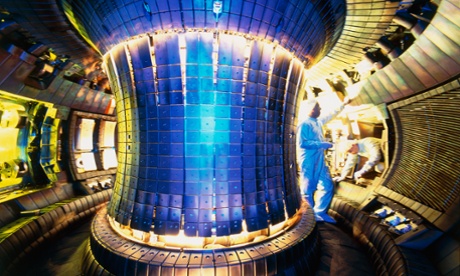Lockheed Announces Breakthrough on Nuclear Fusion Energy
ENERGY, 20 Oct 2014
- 100MW reactor small enough to fit on back of a truck
- Cleaner energy source could be in use within 10 years

An experimental fusion reactor in Munich. Lockheed says its version will fit on the back of a truck. Photograph: Peter Ginter/Peter Ginter/Science Faction/Corbis
Lockheed Martin Corp said on Wednesday [15 Oct 2014] it had made a technological breakthrough in developing a power source based on nuclear fusion, and the first reactors, small enough to fit on the back of a truck, could be ready for use in a decade.
Tom McGuire, who heads the project, said he and a small team had been working on fusion energy at Lockheed’s secretive Skunk Works for about four years, but were now going public to find potential partners in industry and government for their work.
Initial work demonstrated the feasibility of building a 100-megawatt reactor measuring seven feet by 10 feet, which could fit on the back of a large truck, and is about 10 times smaller than current reactors, McGuire told reporters.
In a statement, the company, the Pentagon’s largest supplier, said it would build and test a compact fusion reactor in less than a year, and build a prototype in five years.
In recent years, Lockheed has become increasingly involved in a variety of alternate energy projects, including several ocean energy projects, as it looks to offset a decline in US and European military spending.
Lockheed’s work on fusion energy could help in developing new power sources amid increasing global conflicts over energy, and as projections show there will be a 40% to 50% increase in energy use over the next generation, McGuire said.
If it proves feasible, Lockheed’s work would mark a key breakthrough in a field that scientists have long eyed as promising, but which has not yet yielded viable power systems. The effort seeks to harness the energy released during nuclear fusion, when atoms combine into more stable forms.
“We can make a big difference on the energy front,” McGuire said, noting Lockheed’s 60 years of research on nuclear fusion as a potential energy source that is safer and more efficient than current reactors based on nuclear fission. Lockheed sees the project as part of a comprehensive approach to solving global energy and climate change problems.
Compact nuclear fusion would produce far less waste than coal-powered plants since it would use deuterium-tritium fuel, which can generate nearly 10 million times more energy than the same amount of fossil fuels, the company said.
Ultra-dense deuterium, an isotope of hydrogen, is found in the earth’s oceans, and tritium is made from natural lithium deposits. It said future reactors could use a different fuel and eliminate radioactive waste completely.
McGuire said the company had several patents pending for the work and was looking for partners in academia, industry and among government laboratories to advance the work.
Lockheed said it had shown it could complete a design, build and test it in as little as a year, which should produce an operational reactor in 10 years, McGuire said. A small reactor could power a US navy warship, and eliminate the need for other fuel sources that pose logistical challenges.
US submarines and aircraft carriers run on nuclear power, but they have large fission reactors on board that have to be replaced on a regular cycle.
“What makes our project really interesting and feasible is that timeline as a potential solution,” McGuire said.
Lockheed shares fell 0.6% to $175.02 amid a broad market selloff.
Go to Original – theguardian.com
DISCLAIMER: The statements, views and opinions expressed in pieces republished here are solely those of the authors and do not necessarily represent those of TMS. In accordance with title 17 U.S.C. section 107, this material is distributed without profit to those who have expressed a prior interest in receiving the included information for research and educational purposes. TMS has no affiliation whatsoever with the originator of this article nor is TMS endorsed or sponsored by the originator. “GO TO ORIGINAL” links are provided as a convenience to our readers and allow for verification of authenticity. However, as originating pages are often updated by their originating host sites, the versions posted may not match the versions our readers view when clicking the “GO TO ORIGINAL” links. This site contains copyrighted material the use of which has not always been specifically authorized by the copyright owner. We are making such material available in our efforts to advance understanding of environmental, political, human rights, economic, democracy, scientific, and social justice issues, etc. We believe this constitutes a ‘fair use’ of any such copyrighted material as provided for in section 107 of the US Copyright Law. In accordance with Title 17 U.S.C. Section 107, the material on this site is distributed without profit to those who have expressed a prior interest in receiving the included information for research and educational purposes. For more information go to: http://www.law.cornell.edu/uscode/17/107.shtml. If you wish to use copyrighted material from this site for purposes of your own that go beyond ‘fair use’, you must obtain permission from the copyright owner.